The Best Way to Prepare for SA’s Annual Electricity Price-Hike
Electricity is getting more expensive, and South Africans are looking for ways to ease the pain of paying more for their electricity units every year.
Are there any “hacks” that we can use to save a bit on our monthly spend? Can we prepare in some way for further increases which we know are on their way?
As SA’s online electricity experts and your dedicated electricity partner, Prepaid24 wrote this article to give you a breakdown of Eskom’s recent price increases and, more importantly, show you a way in which you can be smarter about your electricity purchases in order to save as much as possible.
It’s important to note that there is no “silver bullet” for you to avoid Eskom’s increases altogether. Paying more for electricity over time is unavoidable. But there are some practical changes that you can make to your monthly purchases in order to pay less for your units over time than someone who does nothing at all.
Remember, every little improvement and optimisation makes a difference, especially when one is consistent.
How large is 2024’s increase in the context of the last decade?
For 2024, the National Energy Regulator of South Africa (NERSA) has approved an Eskom electricity price increase of 12.74%. This increase has already taken effect for Eskom-direct clients, and municipal clients can expect a similar increase at the end of June.
An increase like the above-mentioned one is nothing new. Eskom’s last 10 electricity price increases can be seen below:
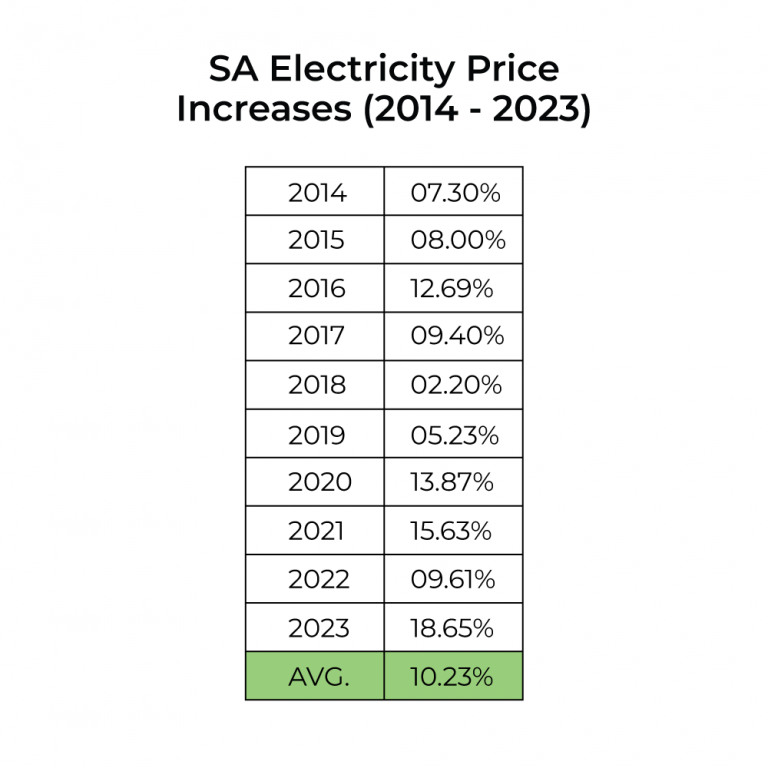
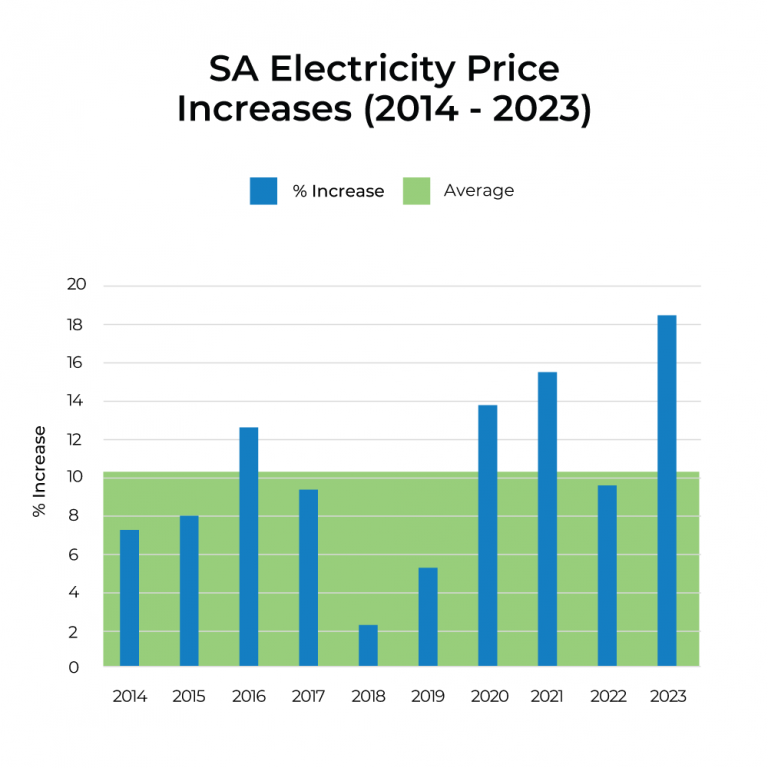
This year’s increase comes in above the last 10 years’ average of 10.23%. We can, however, be thankful that we aren’t facing another 18+% increase like last year!
The reality is that salaries haven’t gone up by anything close to 10% a year, which means that more and more of our previously “leftover” funds are going towards electricity.
The inefficiencies in Eskom are plentiful and well documented, and these steep price-hikes are not slowing down or going away anytime soon.
Which leaves us with some pressing questions: What can South Africans do to curb the effect of rising electricity prices? How can we soften the inevitable blow of Eskom’s annual increases?
Of course, there’s all the usual stuff: Switch off the geyser when you’re not using it, cook with gas (if possible), and make sure you switch all the house’s lights off before you leave for holiday.
We’ve heard all this before and have hopefully applied some of these sound tips to make sure we don’t waste any unnecessary power. But these good habits and tips can only take one so far.
Are there any spending strategies that can help me save something extra on my electricity?
Yes there are. And it’s simpler than you think.
Having serviced electricity consumers all across the country for almost 15 years, Prepaid24 have seen it all – the good, the bad and the ugly.
From what we’ve seen, what has worked best is the “build a buffer” strategy.
What does this strategy entail? It’s all in the name: You want to build up as large of a “buffer” as possible against the municipal electricity price increase before it takes place. And you do this by purchasing a bit more electricity than you actually need and consume during any given month, so that you accumulate extra units on your meter which you can carry over into the months following the price increase.
All the electricity that you buy extra BEFORE the price-hike and carry over past the increase date will essentially be electricity that you “save” on AFTER the price-hike.
Practical Examples:
Let’s take John who lives in Cape Town as a relatable case study:
John’s household normally consumes 752.10 kWh during any given month (costing him R2,500 on the current City of Cape Town tariff). After last year’s massive electricity price increase, he decided to start building a 10% buffer for this year’s price-hike. His purchases and buffer accumulation look as follows (we’ve filled in May and June for him):
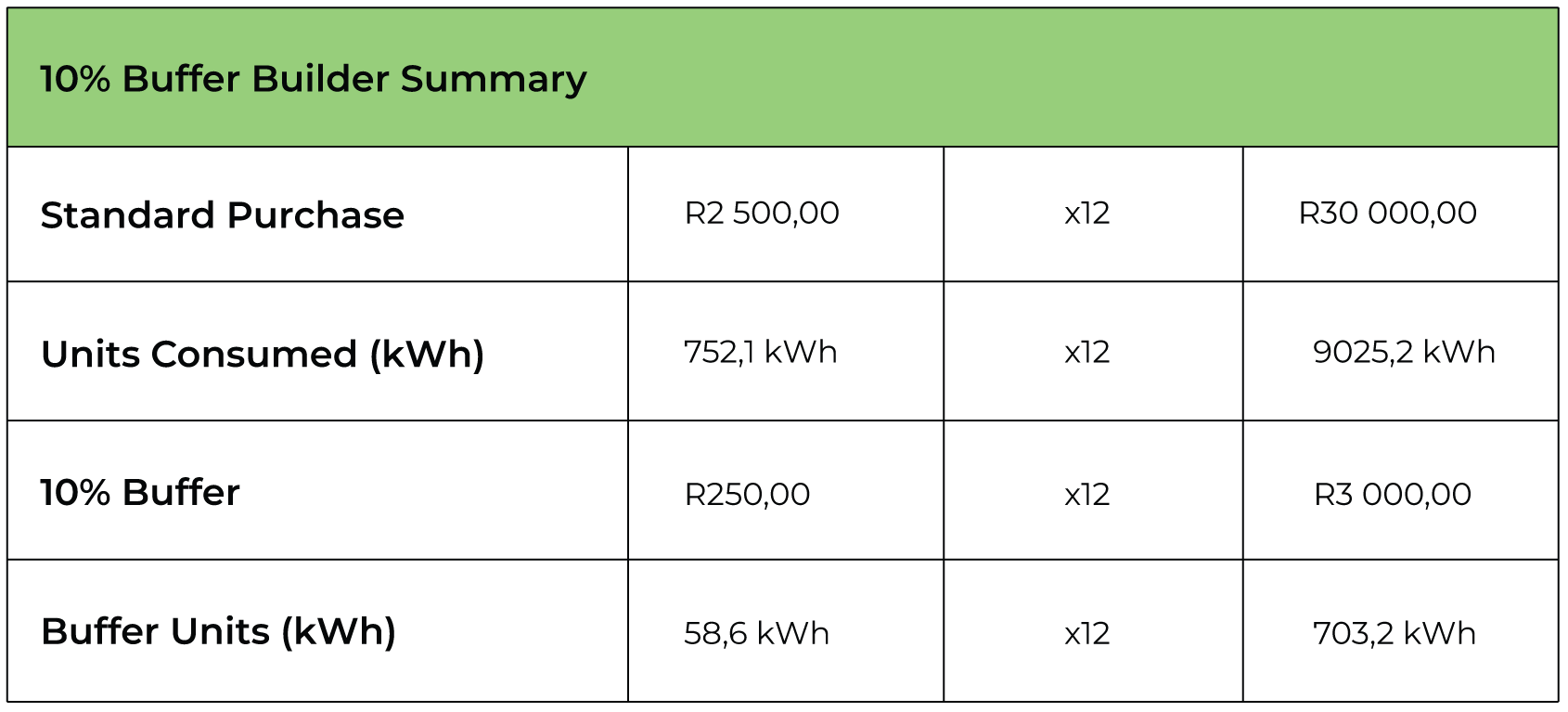
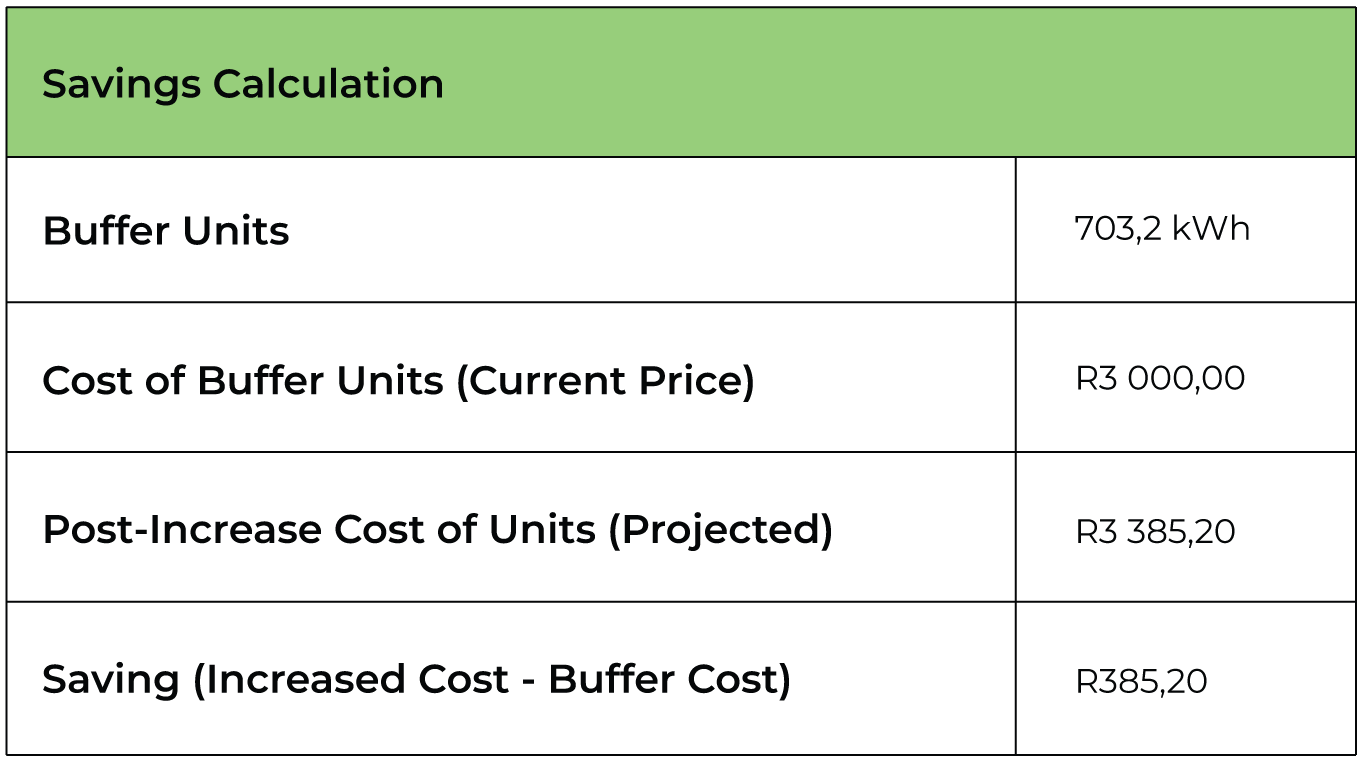
As you can see, in addition to consuming his normal amount of electricity, John has managed to build up a buffer of 703.20 kWh (these extra units cost him R3,000 at the current municipal tariff). If he were to purchase these units at the new increased rate in July, he would pay roughly R3,385.20 for them (assuming that the City of Cape Town raises their tariffs with exactly the same % as Eskom). Thus, John’s reward for building a 10% buffer over the last 12 months is a saving of R385.20.
Now, if John could afford to build a 25% buffer and decided to do so from July 2023, the breakdown would look like this:
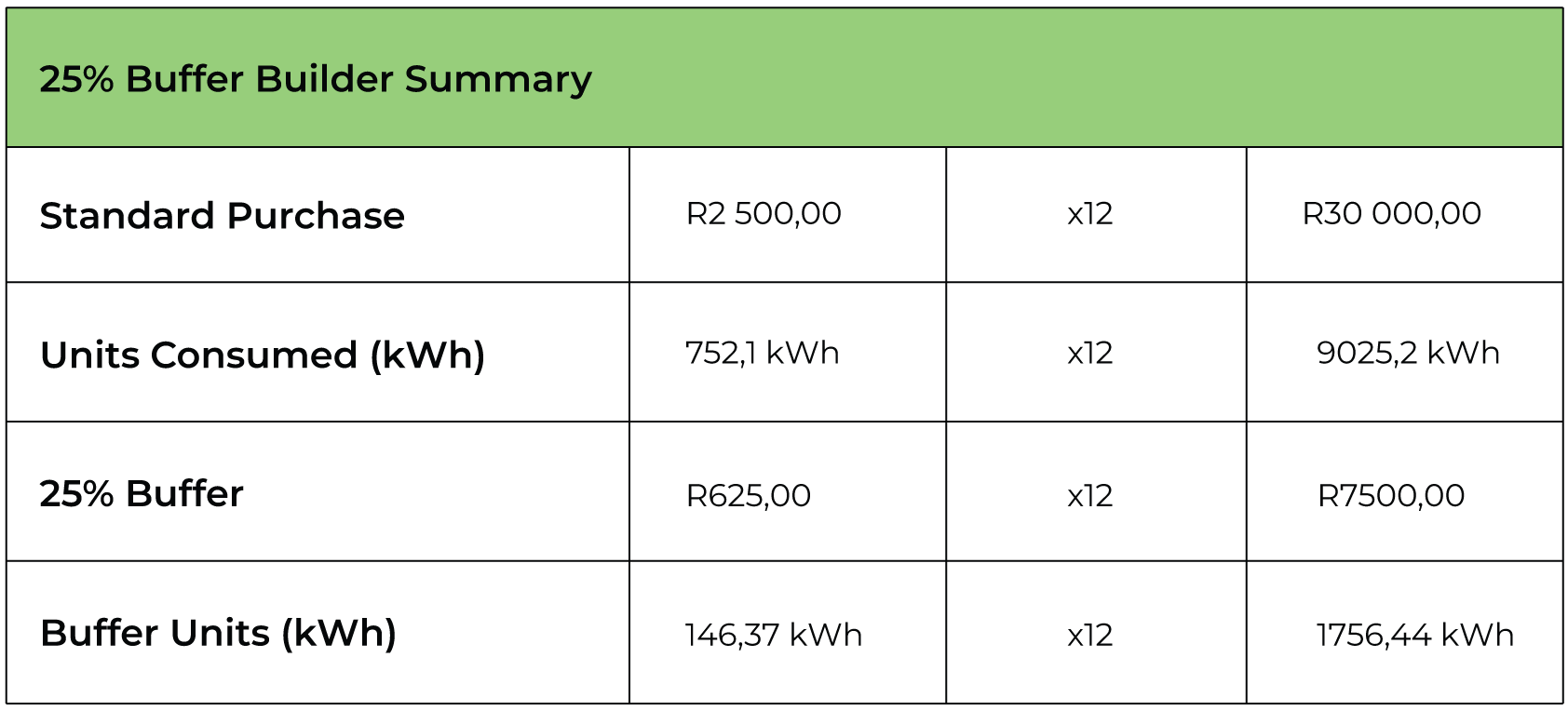
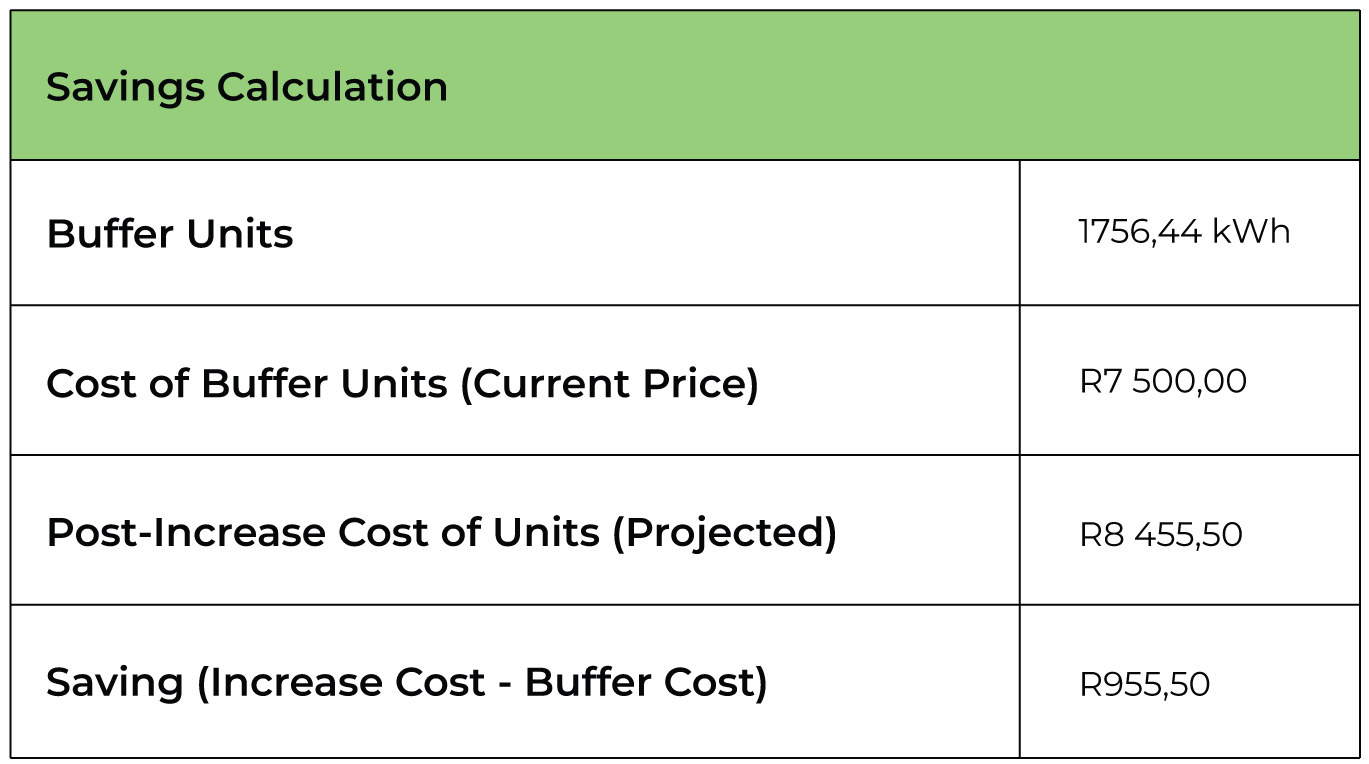
By building a 25% buffer over the last 12 months, John accumulated 1,756.44 kWh extra and was actually able to enjoy the lower rates of 2023 for an extra 2.5 months before he had to start buying electricity at the new increased rate. If he had to purchase these units at the new increased rate, they would have cost him R8,455.50 (instead of the R7,500 he paid when building his buffer), meaning that he effectively saved R955.50.
Given the fact that Eskom’s price increases don’t seem to be slowing down, he will now simply start working on his buffer for next year’s increase.
Obviously, the earlier you can start building your buffer, the better. And the bigger the next electricity price increase is, the greater your effective saving will be over time (though none of us are hoping for even larger price-hikes).
What are some drawbacks and limitations of this strategy?
As mentioned previously, there is no “silver bullet” for South Africans to completely avoid Eskom’s increases altogether. As effective as the “build a buffer” strategy has proven, it cannot be applied by everyone and can only be applied to a certain limit. There are a few reasons for this.
1. Not everyone has extra funds with which to build a buffer.
Not everyone has extra “leftover” funds at the end of the month to spend on building an electricity buffer. Thus, people who can only afford to pay for this month’s electricity will not be able to enjoy the long-term benefit of having bought a bit extra at the current cheaper rate, meaning that they will bear the full brunt of the municipal electricity price-increase when it takes place.
2. Funds used to build a buffer are still limited.
And even for people who can afford to spend a bit extra on electricity every month to build a buffer, funds are never endless, meaning that they will only be able to soften the blow of the annual price increase up to a certain point. When their buffer units eventually run out, they will need to start buying at the higher prices. (Remember: Even though this year’s units are more expensive that last year’s units, they are still cheaper than next year’s units will be – so the opportunity to build a buffer never goes away.)
3. Low-consumption users will not necessarily benefit.
Very important to note is that the “build a buffer” strategy should only be applied by electricity consumers who go through ALL the blocks/steps of their municipal tariff structure every month. As you may know, block tariffs make electricity units more expensive for residents as they move up through purchase brackets, which have ascending rates per unit (kWh). The end result of this is that residents who consume higher volumes of electricity end up paying more per unit.
For a full explanation of Block Tariffs and some much-needed clarity on several of the myths surrounding them, read our article, “Electricity Block/Step Tariffs Explained”.
We can confidently say that consumers who buy electricity in the top block of their municipal tariff every month will benefit from building a buffer as outlined above, because they will continue to buy in this top block after the price increase has taken place. So, if you are going to have to purchase units in the top tariff block after the price increase, rather build a buffer in that top block right now while these units are cheaper.
If, however, you never move into the top block of your municipality’s electricity tariff with your monthly purchases, it will not necessarily be beneficial for you to start building a unit buffer, as your buffer units may be purchased at a more expensive rate than you will pay for them in the lower blocks of the increased tariff structure. For example, if the price of electricity goes up by 12.74% at the end of June and the cost difference between the 2nd and 3rd block of your municipal tariff is 25%, you would be better off to rather wait for the increase and pay 12.74% more for your electricity, instead of building a buffer that could potentially cost you 25% more per unit (which would be more than the upcoming price-hike itself).
Thus, to make sure whether or not you can benefit from the “build a buffer” strategy, you will need to consult your municipal tariff structure. Prepaid24 is more than happy to help with this – feel free to reach out!
Start Small – Every Little Bit Makes a Difference
Our advice to clients who want to know how they can lessen the impact of the upcoming municipal electricity price increase, is to start building a buffer immediately – even if it’s just R50 more than you consume during a normal month. Remember, those R50 tokens will add up, and you will still be getting more electricity for that R50 now than you will get for it after the next price-hike.
NB: Never Skip a Month’s Purchases!
Something many people also don’t realise is how important it is to buy electricity EVERY single month. Why? The answer lies in the Block Tariff structure employed by most South African municipalities, in which the first units you buy during the month are always the cheapest.
By skipping months with your electricity purchases, you are missing out on the cheap Block 1 and Block 2 units that are available to you every month. Unpurchased Block 1 and Block 2 units do not carry over to the next month, so you will not get access to them again. Thus, if you want to make sure you extract as much value out of your electricity purchases as possible, make sure that you at least buy your “cheap” units in all the “discounted” blocks every month.
Pro Tip:
To make 100% sure that they never miss a month’s electricity purchase and automate their “build a buffer” strategy, many Prepaid24 clients have opted to set up Scheduled Electricity Purchases. By setting up a scheduled purchase, you completely eliminate the risk of forgetting an electricity top-up. You’ll simply receive your tokens automatically every month on the date of your choice!
Click here to chat to a consultant that can answer all your questions and assist you to set up a Scheduled Electricity Purchase.
So, as we’ve explained above, there IS something municipal residents can do to combat the upcoming (and all future) electricity price increases. And although this “build a buffer” strategy cannot mitigate the impacts of rising electricity costs altogether, it can certainly soften the blow for many people and help our hard-earned Rands go that little bit further.
Reach Out To Us
As South Africa’s prepaid electricity experts, we want to come alongside electricity consumers to inform and advise them on how to optimise their monthly electricity purchases. Yes, electricity is getting more expensive due to Eskom’s various challenges and shortcomings, but our mission remains to be a ray of light in an admittedly dark industry.
If you’d like to speak to one of our caring electricity experts, feel free to contact us on Prepaid24 Support. We’ll be happy to assist you from 7 am – 11 pm, 365 days a year!
Quick Questions
- Did you find this article insightful or helpful?
- Do you think that one of your friends or family members can benefit from implementing the proven “build a buffer” strategy?
If you do, please share this article through one of the options below. Every single share represents one more informed electricity consumer and is a valuable step in creating a more educated and better serviced South African electricity industry.
Share this article with friends & family!



